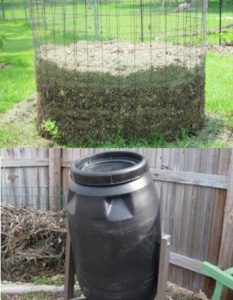A Beginner’s Guide to Setting up a Compost Heap
 WHY COMPOST?
WHY COMPOST?
Composting is a great waste reduction plan for any household. There are so many benefits to it.
• You will be amazed by how much you can reduce the amount of waste you produce.
• Your rubbish won’t smell so bad.
• You have free compost for your garden. This will help your plants grow better and helps increase the soil’s ability to retain water.
• It’s good for the environment. When compostable waste gets sent to landfill, it rots, letting off harmful methane gasses. In a compost heap, it is broken down by microorganisms and no harmful gasses are released.
WHAT SHOULD I DO?
Choose a sunny corner in your garden on some level open ground. This enables good drainage and allows the organisms from the soil to help the composting process. Decide on the size you want your heap to be based on your household and garden size.
The most common (and simplest) way to make compost is to use a compost bin in your garden. You can buy one from your local nursery. A bin helps keep things moist and facilitates the warming that needs to happen for optimal composting and to keep pests away.
It is absolutely possible to simply make a heap. You will need to be more conscientious about layering, occasionally turning your heap to keep it well aerated and ensuring it is kept moist. Consider creating a boundary using some posts with wire wrapped around them or some old pallets or even a few bricks.
Start your compost heap off with some woody material to aid circulation. Then add your green & garden waste.
WHAT CAN I COMPOST?
• Any raw kitchen waste; Fruit or veg that may have gone off, fruit & vegetable peelings, flowers, tea bags, coffee grounds, egg shells (preferably crushed).
• Cooked food waste and bread can also be composted. It’s a good idea to bury these in the pile as they can attract rats and birds. Leave them out if this worries you.
• The contents of you vacuum cleaner, hair & nail clippings.
• Weeds (that have not gone to seed yet), grass, soft cuttings and prunings. Larger pieces take longer to break down. Consider breaking them up a bit before adding them to your heap.
• Waste paper including tissues, kitchen towels, egg boxes and brown cardboard. Avoid glossy and printed paper.
• You can even add logs and thick branches to your compost – but be aware they will break down very slowly. It can be best to put them at the bottom of the pile or even bury them in the ground. Over time they make fantastic compost!
WHAT SHOULD I NOT COMPOST?
• You may want to avoid meat, fish, dairy, fat, pastry, as they can attract rats. (But these can be composted too. If you choose include them it’s best to bury them in the pile and turn the pile from time to time.)
• Cat and dog excrement – this is especially important if you’re going to use your finished compost for vegetable beds.
• Plastic and glossy paper.
• Weeds with seeds, diseased plants. (If your compost pile is large and well managed it will generate enough heat via microbial activity to destroy the seeds and you can add them. Otherwise, if you add them be prepared for the seeds to sprout as new plants.)
• Any garden waste that has been chemically-treated. (While microorganisms can break down some pesticides and inks – you don’t need to be too precious – you do want to avoid harsh chemical treatments as much as possible.)
LAYERING YOUR COMPOST HEAP
Make alternative layers of equal amounts of nitrogen rich “greens”, this includes grass cuttings, fruit peelings etc. and carbon rich “browns” which include paper, dry leaves & sticks etc. The recommended size for the layers is 30cm, use this as a guide rather than a strict rule.
Layering brown and greens keeps a good aeration, and helps prevent your compost heap from getting too wet or too dry. Ideally it should be moist. If it starts looking soggy, add some more dry material and if it starts looking dry, add some more greens. You may need to sprinkle it with a little water if it looks very dry in the hot summer months. Don’t heavily or regularly water your heap. Too much moisture will make it soggy and smelly.
TURNING YOUR COMPOST HEAP
Turning is a hotly debated topic. Some believe it to be essential and some consider it a waste of time. Ideally, your compost heap needs a good mix of wet and dry material which ensures it gets essential air and moisture. It needs heat and micro organisms to aid the composting process. If your heap has all these factors present, leave it to do its thing.
Consider giving it a turn if the composting process has slowed down. It’s not as warm and active as it has been in the past, it has shrunk down and is looking dense but not fully composted. In these scenarios, turning your heap will add some fresh air and fresh food for the microorganisms to continue their work. The oxygenation from turning often stimulates increased activity and breakdown.
WHEN ITS DONE
The composting process in a garden heap can take 3 – 6 months to produce some lovely rich compost. You will know it is ready when it is a dark and crumbly soil like substance. It will smell slightly sweet and earthy. Spread it liberally round your garden and shrubs and watch them flourish.
